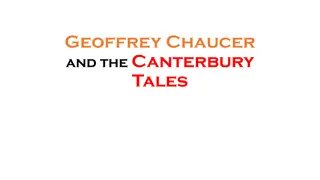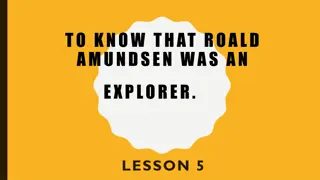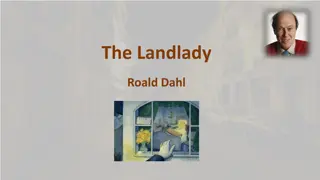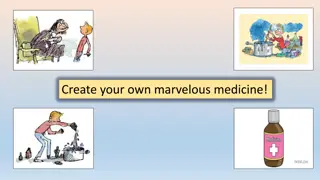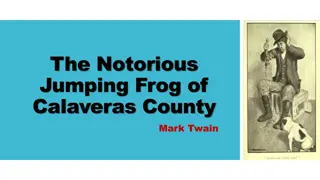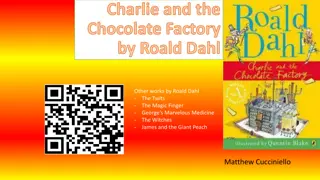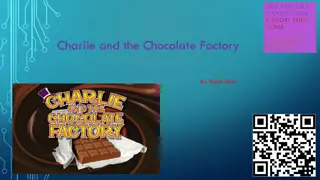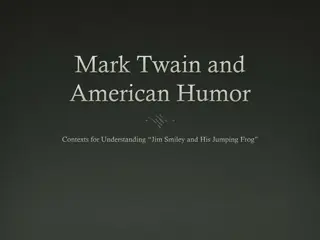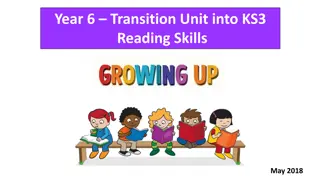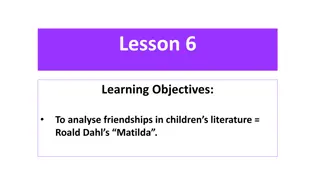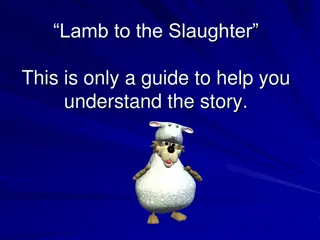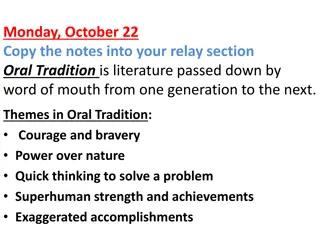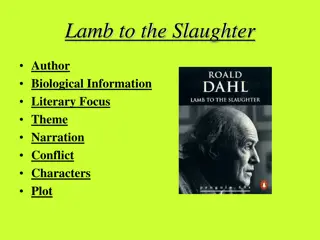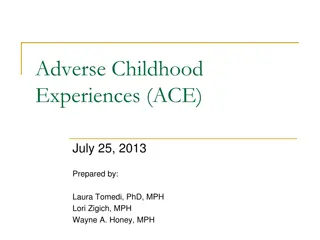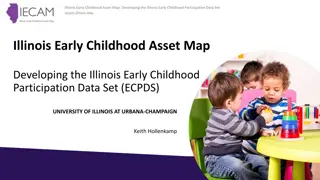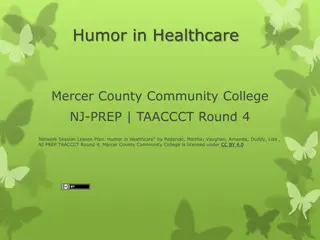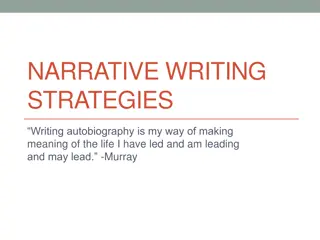Understanding Autobiography, Anecdote, and Humor in Roald Dahl's "Boy: Tales of Childhood
Explore the concepts of autobiography, anecdote, and humor in Roald Dahl's "Boy: Tales of Childhood" through retrieval practice questions and answers. Delve into Dahl's perspective on autobiography, his use of anecdotes, and the humoristic elements present in his storytelling about his childhood. Uncover insights into characters, storytelling techniques, and literary devices employed by Dahl in the book.
Download Presentation

Please find below an Image/Link to download the presentation.
The content on the website is provided AS IS for your information and personal use only. It may not be sold, licensed, or shared on other websites without obtaining consent from the author. Download presentation by click this link. If you encounter any issues during the download, it is possible that the publisher has removed the file from their server.
E N D
Presentation Transcript
Retrieval Practice Boy Tales of Childhood
Retrieval Practice: Lesson 3 1. What is an autobiography? 2. Does Roald Dahl consider Boy to be an autobiography? Why or why not? 3. What is an anecdote? 4. Describe one anecdote we have read about Roald Dahl s father, Harald? 5. What is a humorist? Take 3 minutes to complete these questions 6. What does macabre mean? 7. Describe a macabre moment in Boy so far.
Retrieval Practice Answers: Lesson 3 1. An autobiography an account or telling of a person's life written by that person. 2. Dahl seems to think that most autobiographies are full of boring details; they are a history of a person. Roald Dahl does not consider Boy an autobiography he would never write a boring book; he is telling a series of interesting and important stories about himself as opposed to writing his own history. 3. An anecdote is a short, amusing story about a real person or event. 4. There are several anecdotes about Harald: Harald and Roald Dahl s mom would go on expeditions up into the mountains of Norway and he would scare her by climbing one- handed up steep cliffs to get small plants growing on a rocky ledge; He lost his arm as a little boy after a doctor made a drunken mistake; He believed that if a pregnant woman walked in beautiful places then the child would grow to love beauty. 5. Humorists are artists and thinkers who use comedy in their writing and speaking. 6. Macabre means grim and horrifying because it is related to death or injury. 7. A macabre moment in Boy so far was when Harald was injured and the doctor mistook Harald s fractured elbow for his shoulder, causing him to lose his arm.
Retrieval Practice: Lesson 9 1. What is hyperbole? 2. What is a caricature? Take 3 minutes to complete these questions 3. Name a person whom Dahl caricatures in Boy. 4. Describe a cautionary tale that Thwaites tells his friends. 5. What is a parody? 6. Why might we consider Thwaites cautionary tale to by a parody? 7. What does it mean to be grotesque? 8. Name a character we have met so far whom you might describe as grotesque. Why would you describe them this way? 9. What is artistic license? 10.Why might an author take artistic license when telling a story?
Retrieval Practice Answers: Lesson 9 1. Hyperbole is obvious, intentional exaggeration designed to make a point. 2. A caricature is a description or image of someone with certain aspects exaggerated for comic effect. 3. Mr. Coombs and Mrs. Pratchett are caricatured in Boy. Roald Dahl does this to exaggerate the meanness and ugliness of his characters to emphasize how evil his villains are but also to let us laugh at them. 4. Thwaites tells his friends several cautionary tales: that liquorice is made of rats blood, and that adults put chloroform in Tonsil Ticklers to keep children quiet. 5. A parody is an imitation of a particular idea or style that is exaggerated for comic effect. 6. The stories Thwaites tells are parodies because they re so clearly exaggerated and ridiculous. 7. Grotesque means comically, repulsively ugly or distorted Self-score: ______ /10
Retrieval Practice Answers: Lesson 9 8. Grotesque characters include Mr Coombs and Mrs Pratchett. Both characters are described as comically disgusting. Pratchett is literally filthy and Coombes is greasy and has a face like a ham. 9. Artistic license is the understanding that an author might distort or alter facts slightly in the creation of a piece of literature while maintaining the spirit of the truth. 10. An author might take artistic license in order to infuse their voice or their perspective in the telling of the story. Self-score: ______ /10
Retrieval Practice: Lesson 12 1. What is one characteristic of British humor? 2. What is nostalgia? 3. Describe an aspect of Dahl s trips to Norway that he found to be idyllic. 4. What is penicillin? 5. Why was penicillin an important medical discovery? Take 3 minutes to complete these questions 6. What does it mean to have a stiff upper lip ?
Retrieval Practice: Lesson 12 1. British humor includes innuendo, sarcasm, and dry or deadpan humor. 2. Nostalgia is a fond remembering of the past, especially a longing for a time or place with happy personal memories 3. Dahl found Norway to be idyllic in several ways: visiting his grandparents and eating together in Oslo; sailing down the fjords to the island; the huge breakfast they ate every morning, swimming and playing on their secret island; etc. 4. Penicillin is one of the world s first antibiotics, which are medicines that destroy or slow down the growth of disease-causing bacteria. 5. Penicillin was an important medical discovery because used to treat a wide variety of infections including pneumonia and scarlet fever. It can also heal infections in wounds and has been used to help prevent bacterial complications during and after surgical procedures. Illnesses and injuries that were once dangerous and fatal, such as appendicitis or strep throat, are today considered mild and easy to treat. 6. Having a stiff upper lip means experiencing hardship without showing emotion. Self-score: ______ /6
Retrieval Practice Answers: Lesson 16 1. What is one characteristic of British humor? 2. What event does Dahl describe as an awful pantomime? 3. What does epistolary mean? 4. Describe subversive humor. 5. What is satire? 6. Name a reason that English schoolchildren wore uniforms. Take 3 minutes to complete these questions Self-score: ______ /7
Retrieval Practice Answers: Lesson 16 1. British humor includes innuendo, sarcasm, and dry or deadpan humor. 2. The scene in Mr. Coombe s office is described as awful pantomime. Dahl used the scene to emphasize how performative the adults are during this scene. Instead of a performance designed to entertain children, like a real pantomime, this scene is designed to torture children for the entertainment of the adults. 3. Epistolary is writing that takes the form of a letter from one person to another. 4. Subversive humor is intended to expose, criticize, or undermine systems and institutions of power. 5. Satire is humor that is meant to expose foolishness and flaws. 6. School uniforms emphasize conformity, and proponents believe that they help students fit into a common school culture. Self-score: ______ /6


